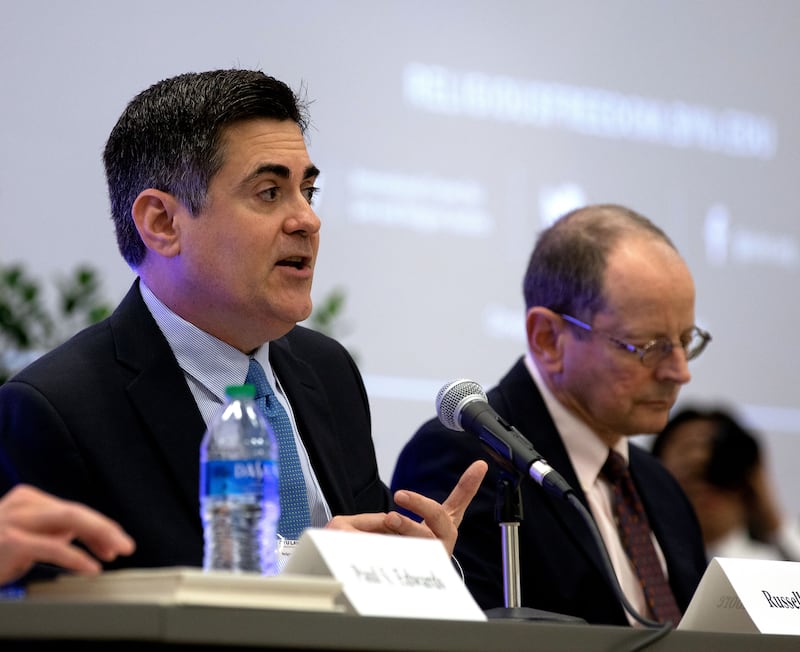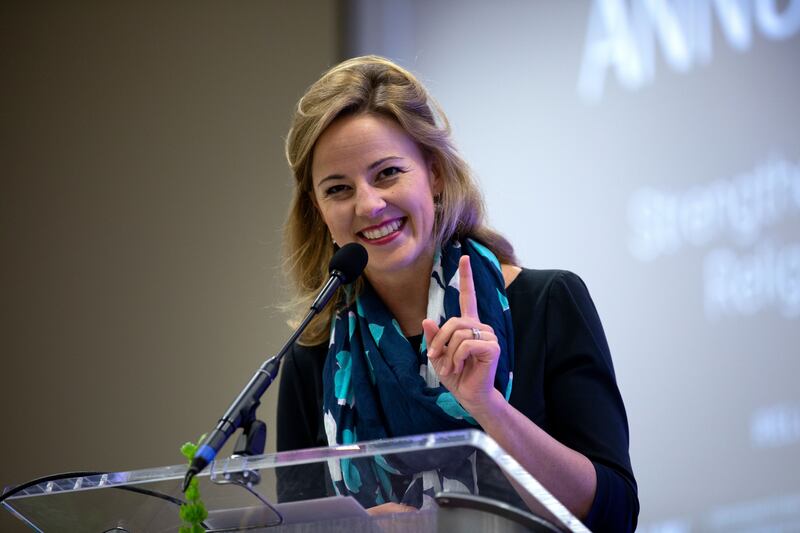People of faith have a stewardship to both preserve religious freedom and to use it to serve others, Elder Clark G. Gilbert, Commissioner of Church Education for The Church of Jesus Christ of Latter-day Saints, said during the capstone address of BYU Law School’s Religious Freedom Annual Review.
The conference, now in its 10th year, spanned several sessions and featured an array of speakers, including Brookings Institution scholar and author Jonathan Rauch, Comment Magazine Editor-in-Chief Anne Snyder and editor-in-chief of Christianity Today Russell Moore.
In his remarks, Elder Gilbert highlighted the history of religious liberty successes and emphasized the importance of recent Supreme Court cases in maintaining religious freedom, but then laid the responsibility for properly using and preserving these freedoms at the feet of believers.
“So the question for tonight is, ‘How will we use these hard-fought victories?’” Elder Gilbert asked. “Religious freedom is not an end unto itself. Our first freedom comes as a stewardship for which we are accountable both to society and to God.”
Elder Gilbert discussed the potential impact of religious universities when they embrace their distinct identity, referencing a special issue of Deseret Magazine titled “Dare to be Different,” which explores the role of religious higher education in America. He said in addition to preserving the particularity of faith traditions through institutions like religious universities, religious individuals must leave the “forest of faith” prepared to articulate and embody their values in the public sphere.
“Our religious stewardship also requires us leaving the forest with courage, to engage even when we do not fit societal norms,” Elder Gilbert said.

Principled pluralism
A major theme from the conference, sponsored by BYU Law School’s International Center for Law and Religion Studies and the Wheatley Institute, was the need to embrace others’ freedoms when protecting religious liberty.
Speakers at the event emphasized that it is the willingness of religious institutions and individuals to negotiate and engage in productive dialogue with those holding different values that forms the basis of a pluralistic society and results in protections for religious organizations of all stripes.
This “principled pluralism,” according to the law center’s director, Brett G. Scharffs, served as the guiding light for the conference.
“Our hope is that this gathering will model the kinds of charitable listening, measured speaking and goodwill that our world sorely needs,” Scharffs said.
The message coming out of the event had less to do with what state and federal governments should do to protect religious rights, and more to do with how people of faith should capitalize on their rights to bring society together.
“If the religious institutions with their deep roots in tradition and morality, their transcendent visions, their ability to transmit this across generations, are not doing the work of giving people moral foundations and identities in society they turn to everything from … wokeness on the left to MAGA on the right,” said Rauch in the conference’s opening session. “And it turns out that those things are not able to transmit lasting values and a deeper sense of meaning.”
Rauch noted that he comes to this observation from his perspective as a “homosexual, atheistic Jew” who nevertheless respects religious belief and recognizes its foundational role in forming a stable society.
Rauch continued: “I believe that the breakdown in the ability of religious institutions to transmit values, what you all call spiritual formation, is an underlying cause, if not the most important cause, of the political crisis we have.”
At the root of this breakdown, according to Moore, is a cynicism, particularly among young people, stemming from how some religious conduct has failed to align with religious teachings. In what would become a refrain of the conference, Moore said the influence of Christianity in America is waning not because of outside attacks or a lack of freedom, but because of a lack of courage to practice on the public stage what is taught from the pulpit, namely, a gospel of peace and reconciliation.

“My greatest concern is not some sort of religious liberty incursion from the outside, it’s not rates of secularization, it’s loss of moral authority within the church,” Moore said. And if religious institutions continue to fall prey to the tribal forces of a polarized society instead of elevating themselves above it, Moore said, we will face “a crisis of disillusionment and cynicism, and I think we’re already there.”
While echoing Moore’s diagnosis, Rauch said there is a model for addressing the misalignment between expressed values and public conduct in religious institutions and that it is found in Utah — in the way The Church of Jesus Christ of Latter-day Saints published a “self-consciously countercultural vision” that hinges on a God-given obligation to “foster negotiation, patience and compromise” in the personal as well as political spheres.
Respect for Marriage Act
This approach is embodied in the Respect for Marriage Act, Rauch said, a law passed by Congress last November that codifies the right to same-sex marriage while establishing protections for religious expression and declaring respect for diverse beliefs about traditional family formation. The church played a key supporting role, along with other faith organizations and LGBTQ advocacy groups, in getting an amended version of the bill passed that balances LGBTQ rights with religious freedom.
The Respect for Marriage Act in its amended form can trace its roots directly back to the “Utah Compromise,” a historic anti-discrimination and religious rights bill passed by the Utah legislature in 2015, panelists said in a breakout session dedicated solely to explaining the Respect for Marriage Act, where it came from and why it is a win for the religious community.

“The Church of Jesus Christ of Latter-day Saints has really led on finding common ground with people who disagree with it,” said Tim Schultz, president of 1st Amendment Partnership, a nonprofit organization that promotes religious freedom policy and education. The church and other allied faith groups have “significant disagreements with claims of LGBT advocates around sexuality and gender” but they sought “to find common ground and peaceful pluralism and that I think more than anything else is the model that people ought to be proud of, not just in Utah but around the country,” he said.
But if religious institutions are to survive and thrive in 21st century America, they need to bring this attitude of compromise and be willing to engage with those of diverse backgrounds, said Thomas B. Griffith, a former judge on the U.S. Court of Appeals for the D.C. Circuit and a current fellow of the Wheatley Institute.
“If we want to maintain the religious freedom that we enjoy so plentifully right now, we better start using it to unite people, and not to divide people,” Griffith said before quoting President Dallin H. Oaks of the First Presidency of The Church of Jesus Christ of Latter-day Saints as saying, “On contested issues, we should seek to moderate and unify.”

Leaving the forest of faith
Speakers at the penultimate general session, led by Comment Magazine Editor-in-Chief Anne Snyder, also sought to draw conference participants’ thoughts inward, reflecting on the essential role of religious institutions in countering societal trends towards isolation and what is happening as some of these institutions shrink.
Snyder reflected on how there was something about the COVID-19 pandemic that revealed “a dry plateau.”
However, Snyder said there remain beacons of hope, and places of “countercultural ferment.” She referred to these places as “life communities,” places that provide sacred time for, as well as demanding everything of, their members.
The question then is: “How to translate some of the critical yeast they developed, not so much critical mass, to revive the stale bread of so many of our church and perhaps other formal religious institutions.”
Elder Gilbert’s response, given at the conclusion of his remarks, is to do more than “hide nervously in the forest of faith and merely mumble the reason for the hope that is in us.”
He continued: “Our defense of religious freedom is always compelling when it preserves our rights of conscience. But it is most inspiring when it moves us to articulate and act on our call to serve others, lift those who struggle, and shine a light to the world.”


